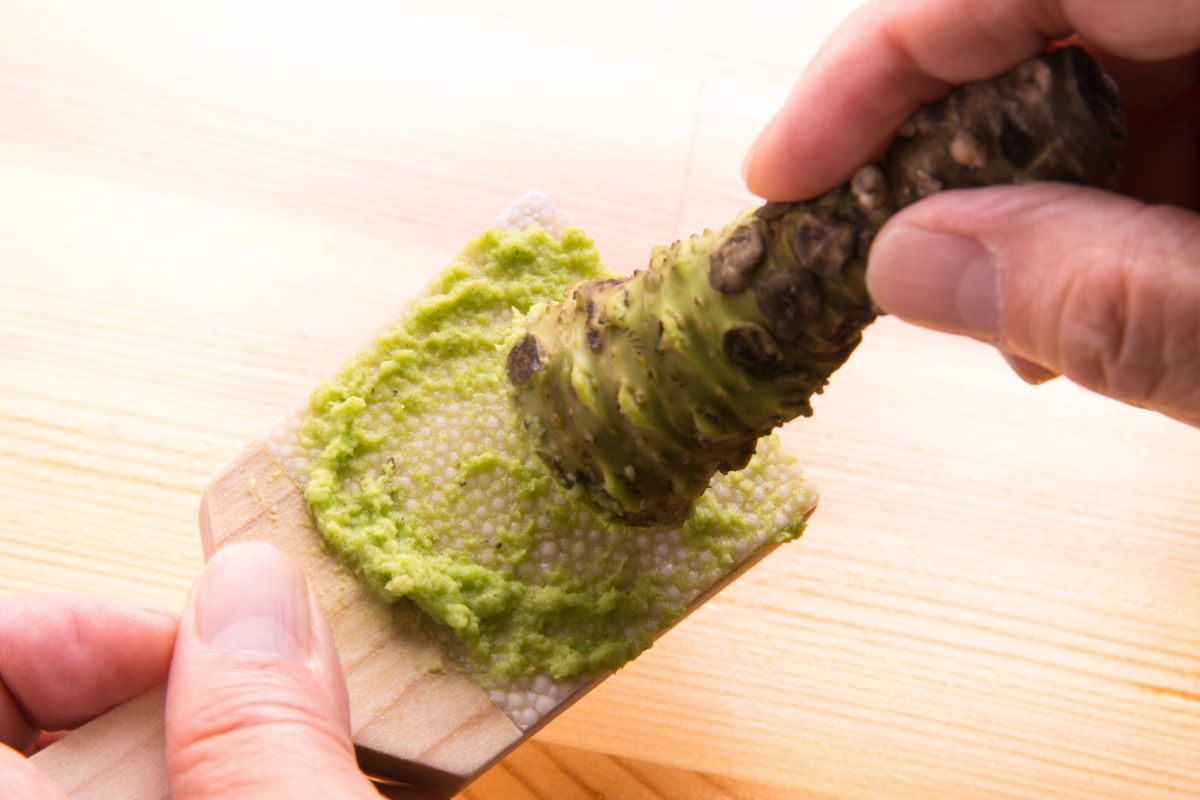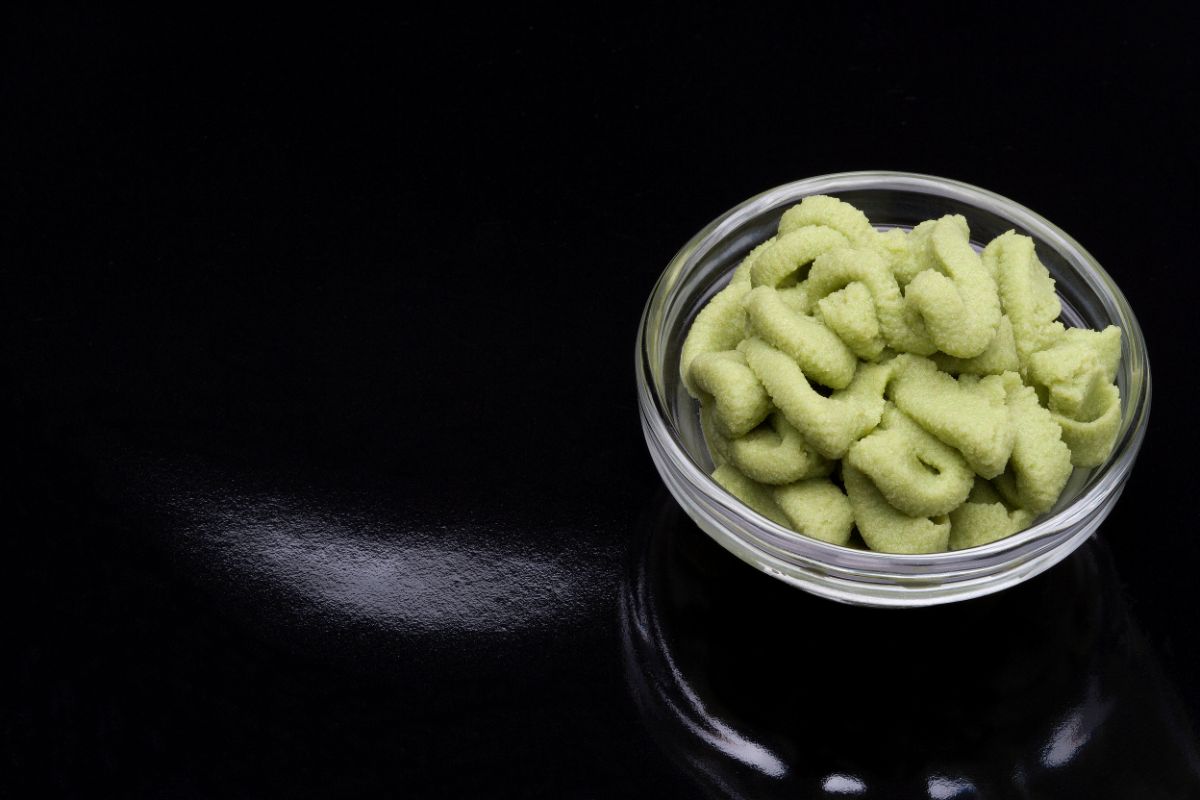There’s a good chance you’ve seen or heard of wasabi before but there’s also a chance you don’t know what it is. If you don’t know what wasabi is, you’ve come to the right place.

The innocent-looking green paste that sits next to your sushi or your California roll is known as wasabi.
Despite being served with a wide range of dishes and all over Asia, not many people actually know what wasabi is.
More often than not, the only thing people know about wasabi is that it’s green and fiery. Today, we want to change that. In this post, you’ll find a wasabi guide that tells you everything you need to know about this green paste.
We’ll tell you exactly what it is, where it comes from, how it tastes, and why it tastes so spicy. If you’re keen to learn more, stay tuned!
What Exactly Is Wasabi?
Let’s start by looking at what wasabi is. Wasabi is most commonly recognized as a spicy green paste.
This green paste is a condiment that can be served with a wide range of different foods. It is added to a dish to add more flavor and a fiery kick of heat.
Whilst wasabi can be used to add heat to any dish, it is most commonly served alongside sushi (see also: Best Sushi In San Diego)and sashimi in Japan.
A surprisingly expensive condiment, wasabi is famous for its clean spiciness, vibrant color, and smooth texture.
Before it’s turned into a green paste, wasabi is a plant that belongs to the Brassicaceae family. It is also commonly referred to as Japanese horseradish.
This plant is native to Japan. It can be found along stream beds in mountain valleys across the country.
Interestingly, excavations across Japan have revealed that wasabi has a history in Japan that dates back to the Jomon period (14,000 BC to 400 BC) when the spice was used as a medicine.
How Is Wasabi Made?
True wasabi is made from the rhizome of a wasabi plant. This part of the plant is found underground in the stem. The underground stem is finely grated in order to create wasabi paste.
Finding and extracting wasabi isn’t the easiest of things to do. Despite its popularity, the plant is actually quite rare, so it can be hard to get hold of.
What Does Wasabi Taste Like?
In terms of taste, true, freshly grated wasabi has a bright green color and a fiery taste. Despite its intense kick, the heat quickly fades away.
The overall flavor of wasabi paste is actually quite mild. It has a pungent but delicate flavor that lets the other ingredients in a dish stand out.
The splash of heat provided by the wasabi is meant to highlight flavor not overwhelm it. Some fake wasabi pastes can overwhelm a dish.
Why Is Wasabi Spicy?
A common question people find themselves asking after trying wasabi for the first time is why is it spicy. The answer to this question is actually quite simple.
Wasabi provides an intense burst of heat because it contains an organic chemical compound called allyl isothiocyanate.
This compound is also found in mustard and horseradish. Our bodies react to this chemical by feeling a strong heat that goes up our noses. Our eyes might water too.
Why Does The Heat Feel Different?
A lot of people that try wasabi also notice that the heat feels different than when we eat other spicy foods. You might think this is just you overthinking things, but it isn’t.
The heat provided by wasabi is different.
The spiciness in wasabi is different from that in other foods. The spice in wasabi comes from allyl isothiocyanate as opposed to pepper capsaicin.
The scent receptors for wasabi’s heat are found deep in our noses, which is why we feel the heat more in our noses than in our mouths.
Why Is Wasabi So Expensive?
The main reason real wasabi is so expensive is that the Wasabia japonica plant is extremely difficult to grow. The plant has to be submerged in moving water to grow, which isn’t a common way of farming.

Wasabia japonica is also a very sensitive plant that’s very easy to kill. As a result, wasabi isn’t harvested in many places, even in Japan. Therefore, it is very rare and hard to get hold of. This increases its price.
In most kitchens and grocery stores, this has led to fake wasabi being the preferred choice.
What Is Fake Wasabi Made Out Of?
Most wasabi found in grocery stores and restaurants is what we call fake wasabi.
Fake wasabi is usually made from artificial colors and horseradish. Some brands of fake wasabi also contain mustard powder and some sort of thickening agent like cornstarch or flour.
Fake wasabi actually tastes pretty great. Horseradish belongs to the same family as wasabi, so the two share a similar flavor and spicy kick.
How To Tell The Difference Between Fake And Real Wasabi
Spotting the difference between fake and real wasabi isn’t that difficult. In fact, there are a number of tell-tale signs that make it very obvious. The main difference between fake and real wasabi is the texture.
Fake wasabi has a pasty and thick consistency, whilst real wasabi is always freshly greeted, giving it a more gritty texture. The other way to spot the difference between the two is through taste.
Real wasabi has an intense kick that fades away quickly. On the other hand, fake wasabi burns a lot hotter and for longer because it usually contains horseradish and mustard.
Final Thoughts
This guide has told you everything you need to know about wasabi. Wasabi is an interesting condiment that doesn’t add much flavor to a dish. However, it does add a wonderful burst of spice to our food.
Now you know more about what wasabi is and how it is made, you’ll know exactly what you’re eating the next time you’re served it. Thanks to this guide, you should also be able to tell if it’s the real thing or not.
- Dealing With Mold on Oyster Mushrooms - April 9, 2024
- What Meat Goes With Pumpkin Ravioli? (Ravishing Ravioli Combos) - March 15, 2024
- What To Dip Cheetos In? (Crunchy Cheese Puffs Concoctions) - March 4, 2024
